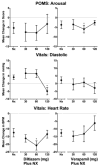Effects of prototypic calcium channel blockers in methadone-maintained humans responding under a naloxone discrimination procedure
- PMID: 23524089
- PMCID: PMC3759565
- DOI: 10.1016/j.ejphar.2013.03.007
Effects of prototypic calcium channel blockers in methadone-maintained humans responding under a naloxone discrimination procedure
Abstract
Accumulating evidence suggests that L-type calcium channel blockers (CCBs) attenuate the expression of opioid withdrawal and the dihydropyridine L-type CCB isradipine has been shown to block the behavioral effects of naloxone in opioid-maintained humans. This study determined whether two prototypic L-type CCBs with differing chemical structures, the benzothiazepine diltiazem and the phenylalkamine verapamil, attenuate the behavioral effects of naloxone in methadone-maintained humans trained to distinguish between low-dose naloxone (0.15 mg/70 kg, i.m.) and placebo under an instructed novel-response drug discrimination procedure. Once discrimination was acquired, diltiazem (0, 30, 60, 120 mg) and verapamil (0, 30, 60, 120 mg), alone and combined with the training dose of naloxone, were tested. Diltiazem alone produced 33-50% naloxone- and novel-appropriate responding at 30 and 60 mg and essentially placebo-appropriate responding at 120 mg. Verapamil alone produced 20-40% naloxone- and 0% novel-appropriate responding. Diltiazem at 60 mg decreased several ratings associated with positive mood and increased VAS ratings of "Bad Drug Effects" relative to placebo, whereas verapamil increased ratings associated with euphoria. When administered with naloxone, diltiazem produced 94-100% naloxone-appropriate-responding with 6% novel-appropriate responding at 60 mg (n=3). When administered with naloxone, verapamil produced 60-80% naloxone- and 0% novel-appropriate responding (n=5). Diltiazem decreased diastolic blood pressure and heart rate whereas verapamil decreased ratings of arousal relative to placebo. These results suggest that CCBs with different chemical structures can be differentiated behaviorally, and that diltiazem and verapamil do not attenuate the discriminative stimulus effects of naloxone in humans at the doses tested.
Keywords: Calcium channel blocker; Drug discrimination; Humans; Naloxone; Opioid dependence; Opioid withdrawal.
© 2013 Elsevier B.V. All rights reserved.
Conflict of interest statement
For all authors, no conflicts of interests have been declared.
Figures




Similar articles
-
Gabapentin and D-cycloserine alone and in combination with naloxone in methadone-maintained humans responding under a naloxone novel-response discrimination procedure.Behav Pharmacol. 2025 Aug 1;36(5):265-275. doi: 10.1097/FBP.0000000000000823. Epub 2025 Apr 8. Behav Pharmacol. 2025. PMID: 40272204 Clinical Trial.
-
Isradipine and dextromethorphan in methadone-maintained humans under a naloxone discrimination procedure.Eur J Pharmacol. 2004 May 3;491(2-3):157-68. doi: 10.1016/j.ejphar.2004.03.024. Eur J Pharmacol. 2004. PMID: 15140632 Clinical Trial.
-
Differential effects of L-type calcium channel blockers and stimulants on naloxone-precipitated withdrawal in mice acutely dependent on morphine.Psychopharmacology (Berl). 1991;104(3):397-403. doi: 10.1007/BF02246042. Psychopharmacology (Berl). 1991. PMID: 1718013
-
Combination therapy with calcium-channel blockers and beta blockers for chronic stable angina pectoris.Am J Cardiol. 1985 Jan 25;55(3):69B-80B. doi: 10.1016/0002-9149(85)90615-0. Am J Cardiol. 1985. PMID: 2857518 Review.
-
Calcium-channel blocking agents.Clin Pharm. 1982 Jan-Feb;1(1):17-33. Clin Pharm. 1982. PMID: 6764159 Review.
Cited by
-
Human Drug Discrimination: Elucidating the Neuropharmacology of Commonly Abused Illicit Drugs.Curr Top Behav Neurosci. 2018;39:261-295. doi: 10.1007/7854_2016_10. Curr Top Behav Neurosci. 2018. PMID: 27272070 Free PMC article. Review.
-
Human drug discrimination: A primer and methodological review.Exp Clin Psychopharmacol. 2016 Aug;24(4):214-28. doi: 10.1037/pha0000077. Exp Clin Psychopharmacol. 2016. PMID: 27454673 Free PMC article. Review.
-
Gabapentin and D-cycloserine alone and in combination with naloxone in methadone-maintained humans responding under a naloxone novel-response discrimination procedure.Behav Pharmacol. 2025 Aug 1;36(5):265-275. doi: 10.1097/FBP.0000000000000823. Epub 2025 Apr 8. Behav Pharmacol. 2025. PMID: 40272204 Clinical Trial.
-
The calcium channel agonist (±)-BAY-K-8644 attenuates the ability of gabapentinoids to increase the potency of fentanyl and heroin and decrease the potency of cocaine and d-methamphetamine to elicit discriminative stimulus effects in rats.J Pharmacol Exp Ther. 2025 May;392(5):103523. doi: 10.1016/j.jpet.2025.103523. Epub 2025 Apr 2. J Pharmacol Exp Ther. 2025. PMID: 40253987 Free PMC article.
References
-
- Amato L, Davoli M, Minozzi S, Ali R, Ferri M. Methadone at tapered doses for the management of opioid withdrawal. Cochrane Database Syst Rev. 2005 Jul 20;:CD003409. - PubMed
-
- Baeyens JM, Esposito E, Ossowska G, Samanin R. Effects of peripheral and central administration of calcium channel blockers in the naloxone-precipitated abstinence syndrome in morphine-dependent rats. Eur J Pharmacol. 1987;137:9–13. - PubMed
-
- Barrios M, Baeyens JM. Differential effects of L-type calcium channel blockers and stimulants on naloxone-precipitated withdrawal in mice acutely dependent on morphine. Psychopharmacology. 1991;104:397–403. - PubMed
Publication types
MeSH terms
Substances
Grants and funding
LinkOut - more resources
Full Text Sources
Other Literature Sources
Research Materials

